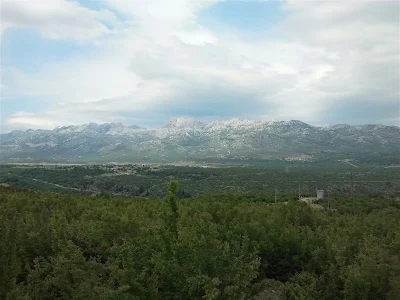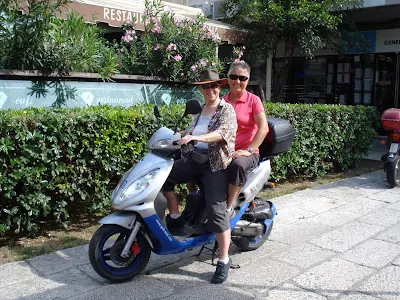 |
Velebit Mountain views between Plitvice and Zadar
|
We had the impressive Velebit Mountain range in our view for part of
the trip, and after about 2 hours, we were in Zadar on the Adriatic Sea.
We found Borik Camping in Zadar. It’s right on the edge of the beach
with awesome views across the bay, and not too many people. It was very
peaceful so we spent a couple of days there, just relaxing by the sea.
Zadar is the oldest continuously-inhabited city in Croatia. We
enjoyed walking around the old city, where we found plenty of interesting, and
historic places to explore.
On the waterfront, we were impressed by the Sea Organ art
installation. This is a series of holes cut into the harbour promenade, so
that, when the sea is choppy, the waves and wind blow through the holes
creating a grunty, whistling type of music. We just loved the haunting sounds
produced by this innovation.
We walked through the impressive city gate called Kopenena Vrata,
which is a UNESCO World Heritage site. We also enjoyed the ethnographic museum,
and the old town walls.
We particularly liked the ancient stone, and majesty of the 9th
century St. Donatus church and its unusual rotunda, along with the nearby Roman
Forum ruins.
Driving south from Zadar a few days later, we took the coast road,
enjoying spectacular sea views, and lots of attractive villages on the way. We
took a little detour to the historic city of Šibenik, to see the St James
Cathedral, a UNESCO World Heritage Site.
A couple of hours later, we arrived near Trogir and decided to stop
there for lunch. Trogir is on a small island off the Adriatic coast. Its known
for the preservation of its medieval city, and is a UNESCO World Heritage site.
Somehow, we found a car park, and then crossed a bridge into the old
city. Wow, it’s stunning, full of Renaissance and Baroque architecture, and
with some of its medieval walls intact. We instantly wanted to explore this
lovely place.
We spent quite a bit of time, wandering its tiny medieval streets,
enjoying the wide promenade that meanders around the town, and discovering its
architectural delights.
At one stage, we emerged from a narrow, cobbled street into a lovely
compact square, and found Restaurant Vanjaka. We decided to eat there and had a
locally made pag cheese appetizer, and fantastic shellfish meal.
 |
| Trogir street |
After lunch, we decided to move on and explore more of the beautiful
Croatian coastline.
We were headed for a campsite we’d read about just past Trogir.
However, we couldn’t find the camp, so decided to follow signs to a tourist
information centre in the nearby village of Kaštel Stari.
Because the road looked too narrow for our big campervan, we drove
on a few blocks then turned down another street, marked ‘Town Centre’. It was
smallish but one-way, so ok.
Shortly after, we found a parking space - a major achievement in our
large campervan in a small village. But, after asking the locals for
directions, we learned there was no information centre or campsite.
So, back in the campervan, we drove on through the rest of the
one-way street, only to find that it became narrower the further we went.
At the bottom, the street went to the left, so we had no choice but
to turn. But the corner café owner accused us of hitting his overhanging
awning. In fact, we only touched a vine on the edge!
Then we couldn’t fit through the street as a builder’s van was in
the way. He drove into a lane, and so on we went.
Rounding the next corner, we found we had to go up the same street
that earlier, we thought was too narrow. By this time, we were very, very
nervous about getting out of this village!
So, taking a deep breath, we folded our wing-mirrors back and with
Marg driving, and Leigh in the street guiding us forward millimetre by
millimetre (literally), we got past the first couple of parked cars. By now,
the locals had become interested, giving advice on which way to edge forward.
In this way, we managed to get past another parked car without
leaving behind any paint on either it, or the wall of the house on the other
side - a major achievement as there was absolutely NO spare room. Three cars
down and six more to go!
By now, several locals were out on the street, or hanging out of
their window or door, to see the mad Kiwis drive their big campervan down their
street.
Several more cars had to be passed to be free, and one anxious
chappie quickly moved his Jeep into a driveway, and a woman rushed out to tell
us she was moving her car – that helped.
After that, we think the village grapevine advertised our coming,
because the next minute, several people rushed out of their house and moved
their car out of our way. A few moments later, we squeezed out and back onto
the main street.
 |
Our 50cc motor scooter hired in Split
|
This was Camping Stobreč, well located, just south of Split. Sitting
in the campsite after such an eventful day, we were rewarded with a beautiful
sunset over the water, and a good night’s sleep.
Then next morning, we hired a 50cc motor scooter to get around
Split, and manage the narrow streets. The weather was fantastic for our entire
stay and the scooter was great fun.
Split is the second-largest city in Croatia. It’s another very old
city, having its roots in Roman times, shown by its marble streets dating back
to the 3rd century. It’s also a UNESCO site.
We spent the next day in Split and enjoyed the Diocletian's Palace,
in itself, a UNESCO site. It’s a bit like a walled town within the city, and
now days, has churches, shops, bars and cafes inside its walls.
Split is known for its fresh sea food and wine, making various red
wines like merlot, cabernet, plavac, dingac, and white wines like malvazija,
posip, and others. We drank a great deal of posip!
We enjoyed the ancient centre, and beautiful architecture. But what
we really admired, was the creativity in drying washing. Washing lines were
strung from one building to another across the narrow streets, but how they got
it up there, in such high and awkward places, was a mystery to us.
Eventually, we moved on, and our next stop was Neum. This little
town is actually in Bosnia & Herzegovina, which has a short 20 km stretch
of coastline that divides Croatia’s north and south. We had a brief passport
check as we drove in but no problems.
Neum itself is nice. We wound our way down to the waterfront for a
quick look then kept going.
Next, we drove on to the Peljesac Peninsula of Crotia. On the peninsular, we
passed the amazing walls of Ston village. These are massive stone walls built
in the 14th and 15th centuries to protect the lucrative salt pans at the time.
The walls are often called the Great Walls of Europe, and meander over the
hills for around 5 km.
At the end of the Peninsula is Orebic which was our base for a trip
to the island of Korčula.
Disembarking the ferry in Korčula, we immediately noticed the town
walls and entry portal built in the 15th century. Then we walked around the
lovely old city and had a great day, and yet another gorgeous seafood lunch
while sitting at a waterfront restaurant. The weather had become hotter as we
came further south, so we headed for the shady table.
The stone carvers did a great job in Korčula, leaving some beautiful
facades on Korčula’s historic architecture.
Returning on the ferry later, we could really see the beauty of the
island - soft grey walls and buildings, red roofs, and green forest, on a
backdrop of a beautiful Mediterranean blue sky. It was lovely.
Back in the campervan, we returned to Orebic to their camping ground,
where we found a great parking spot in a lovely shaded area overlooking the
Adriatic.
The next day, we drove to Dubrovnik, alongside some of the most
spectacular coastal scenery.
Dubrovnik is beautiful and ancient, dating back to the 7th century.
It is a UNESCO World Heritage site.
We walked the city wall, the most intact and impressive seen on this
trip.
In the old town, we wended our way along Dubrovnik’s shiny marble
streets, lined with beautiful baroque buildings.
We visited the 14th century Rector’s Palace, the monastery, and
cathedral and soaked up the local atmosphere. We loved it.
After a full-on day, including a boat trip around the coastal areas,
we headed back to our campervan. For the next few nights, we camped at Camp Solitudo, about 10
minutes out of Dubrovnik.
This is to be our last stop in Croatia and we have absolutely loved
it; the people, the scenery, the history, and the vibrancy of all of the towns
we have stayed in.
Eventually, we had to move on, and our next stop is Montenegro.










